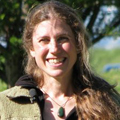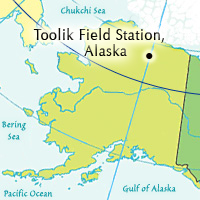Inventorying Arctic Vegetation
TOOLIK FIELD STATION, ALASKA– To understand how the Arctic tundra changes over time, we are inventorying long-term vegetation plots established in the vicinity of Toolik Lake nearly twenty years ago.
We will compare the plant community composition (or variety and abundance of different plant species) of the initial survey to the data we are collecting now. This allows us to see how the quantity and variety of plants here have changed over the past decades. We will monitor these changes in groups of plants such as shrubs, herbs, grasses and lichens.
To inventory the vegetation we use the ‘point-frame method’, where a one square meter frame is placed above the plot on legs sunk deep into the tundra. The point-frame contains a grid of fishing line that forms 100 points placed every 5 centimeters. At each of these points, we identify the top and bottom plant species, the plant height, whether the plant is living, and, for woody plants, if the part of the plant at that point is vegetative or woody. Occasionally, we must diverge from the task to identify unknown plants.
In this video meet my field partners, Joel and Sayuri, as they proceed with the inventory amidst the rolling tundra, mosquitoes and a resident Lapland Longspur.
Get the Flash Player to see this player.











I really liked your video about vegetation research in Alaska. It must be hard to concentrate on your work with all those mosquitos! Your field site looks really beautiful though- thanks for sharing.
Are those special hooded robes you wear to protect against the mosquitos?
Those are bug jackets. They are ‘charged’ with >90% deet and stored in a plastic ziploc bag. They act as a mosquito deterrent. Overall though, you have to enter a zen-like state so that you are one with the mosquitoes to survive on particularly bad days.
Beautiful video.
I like the cinematography, but also the soundtrack ;-) … the wind, the mosquitoes buzzing, the bird calls… I can almost smell the tundra…
Thanks!
Ian
Dear Amy,
I am very interested in your work and I would like to know more details about it. Last week I wrote you an email…
I hope everything is alright.
Jose
Amy,
Wishing you post haste with your P.H.D. You are “in the group of leaders” that will help save the planet. What an awesome undertaking.
Speaking for humanity…
I love you and we all love you!
Juli